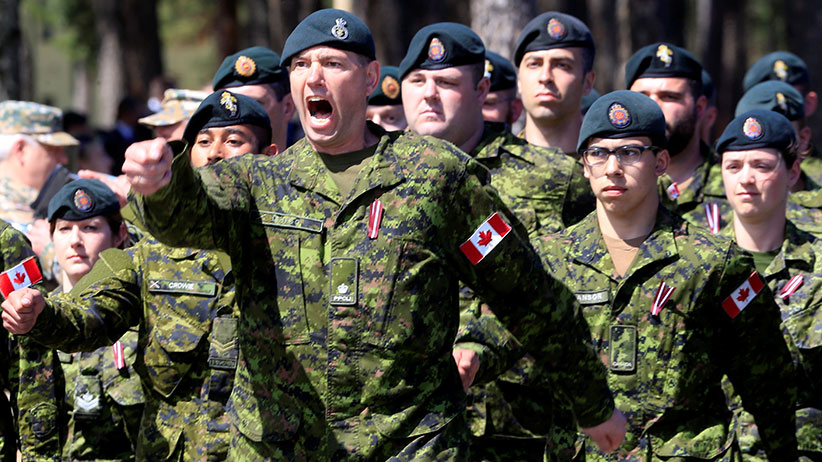Canada’s mission to scare off Russia
Paul Wells visits Camp Adazi, Latvia, where a Canadian-led battlegroup marked its first official day on the job
(Ints Kalnins/Reuters)
Share

If you’re going to get into a mess with no idea when you’ll ever get out, there are worse places to do it. On Monday more than 400 Canadian soldiers stood in the midday sun on the parade square at Camp Adazi, a Latvian army base tucked into a pine forest northeast of Riga, the tiny Baltic nation’s capital. To the right of the Canadians stood about as many Latvian troops. On either side were smaller groups of Spanish, Italian, Polish, Slovenian and Albanian soldiers.
This is the Canadian-led battlegroup, 1,138 troops in full from the six visitor nations, plus their Latvian hosts, and Monday was the newcomers’ first official day on the job. On hand for a welcoming ceremony were Latvia’s president Raimonds Vējonis, NATO’s secretary-general Jens Stoltenberg, Canada’s defence minister Harjit Sajjan, and the top soldier in every participating country’s armed forces, including Canada’s chief of defence staff, Gen. Jonathan Vance.
Their mission is to scare off the Russians. Probably it will work. Everybody’s pretty sure it will work. If it didn’t work, things would get very nasty here.
But this was a day for looking on the bright side. “Many of you have travelled over 7,000 km, all the way from Alberta, Canada, to serve here in the Eastern part of the alliance,” Stoltenberg told the troops. And indeed it’s so, because the first Canadians to serve a six-month rotation here are from the 1st Battalion of Princess Patricia’s Canadian Light Infantry, stationed in Edmonton. “You embody the unique spirit and solidarity of NATO,” Stoltenberg told them.
There was much talk of solidarity. “Our alliance stands as one,” Stoltenberg said. “An attack on one ally will be regarded as an attack on all.”
That’s what NATO was designed for, back in the middle of the 20th century, during a cold war everyone here insists they don’t want to see returning. Article 5 of the North Atlantic Treaty says that an attack on any member state will meet a response from them all. NATO didn’t have Georgia’s back when Vladimir Putin invaded that country in 2008, nor did it really have Ukraine’s when Russia annexed Crimea and made trouble in other regions of Eastern Ukraine in 2014. They weren’t NATO member states. Latvia, Lithuanian and Estonia are, which is why there is a NATO battlegroup in each of those Baltic countries and in Poland, starting today: To make it crystal-clear that invading a NATO member state would not be fun.
“If somebody will attack any NATO country, it means it is an attack on NATO, and everybody will have to help this attacked country,” Vējonis, the Latvian president, said. “But I don’t believe Russia will attack a NATO country because it can raise” — that is, provoke — “a real war. And I am sure Russia is not ready for a huge-scale war.”
This is probably a good bet. This Canadian-led battlegroup has teeth: Canadian, Italian and Spanish mechanized infantry companies, plus a Polish tank company for even heavier firepower. Battlegroups in the other countries bring the total number of soldiers assigned to NATO’s so-called Enhanced Forward Presence to 4,530.
Still, that would be a disappointing turnout for a Lumineers concert, and the gang on the other side of the fence is massive: in August the Russians and neighbouring Belarusians will launch the latest version of Zapad, a massive war-game exercise Russia holds every three or four years that mobilizes between 50,000 and 100,000 troops.
The mismatch is, to some degree, part of the message, officials said: it’s harder to perceive a deployment on the scale of NATO’s Enhanced Forward Presence as a provocation. Although one suspects the Russians will manage. And if anyone ever did move into the Baltics in a big way, the EFP battlegroups wouldn’t be the only response. NATO has tripled its multinational Response Force to 40,000 troops. A new Spearhead Force can send 5,000 soldiers within days.
So the Canadians at Camp Adazi and their colleagues across the region are there to be a tripwire, or to stave off aggressors until reinforcements arrive. “Can’t give away all the trade secrets to you,” Vance said, but “the response plans, of which there are many… would be swift and quite decisive.”
In the meantime, the Canadians will drill, practice, rehearse, and plan for a confrontation they hope their very presence will forestall. After six months the Princess Patricias will rotate home, to be replaced by someone else. Climate and camp infrastructure will keep the work from being too unpleasant. “This is better than some of our camps” back home, a Canadian soldier said on Monday morning.
Best case, the Russians were never going to invade and this whole effort is a waste. Worst case, an invasion would overwhelm the tenants of Camp Adazi in days. There are a thousand middle cases, aggression that may once have been worth the risk that now, perhaps, won’t be. That middle ground is terrain the Canadians and their NATO allies have now begun to patrol.